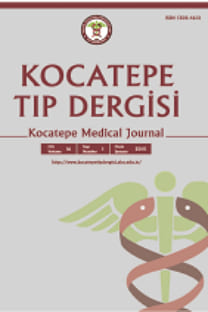Abdominal ve Laparoskopik Myomektomilerin Postoperatif Komplikasyonlar ve Fertilite Açısından Değerlendirilmesi
Laparoskopik myomektomi, abdominal myomektomi, komplikasyon, fertilite
Abdominal ve Laparoskopik Myomektomilerin Postoperatif Komplikasyonlar ve Fertilite Açısından Değerlendirilmesi
Laparoscopic myomectomy, abdominal myomectomy, complication, fertility,
___
- Wallach EE, Vlahos NF. Uterine myomas: an overwiew of development, clinical features, and management. Obstet Gynecol 2004;104(2):393- 406.
- Jacoby VL, Fujimoto VY, Giudice LC, Kuppermann M, Washington AE. Racial and ethnic disparities in benign gynecologic conditions and associated surgeries. Am J Obstet Gynecol 2010;202(6):514- 521.
- Islam MS, Protic O, Giannubilo SR, et al. Uterine leiomyoma: available medical treatments and new possible therapeutic options. J Clin Endocrinol Metab 2013;98(3):921-34.
- Tal R, Segars JH. The role of angiogenic factors in fibroidpathogenesis: potential implications for future therapy. Hum Reprod Update 2014;20(2):194-216.
- Jin C, Hu Y, Chen XC, et al. Laparoscopic versus open myomectomy--a meta-analysis of randomized controlled trials. Eur J Obstet Gynecol Reprod Biol 2009;145(1):14-21.
- Cheng MH, Wang PH. Uterine myoma: a condition amenable to medical therapy? Expert Opin Emerg Drugs 2008;13(1):119-33.
- Semm K. New methods of pelviscopy (gynecologic laparoscopy) for myomectomy, ovariectomy, tubectomy 1979;11(2):85-93. adnectomy. Endoscopy
- Payne TN, Pitter MC. Robotic-assisted surgery for the community gynecologist: can it be adopted? Clin Obstet Gynecol 2011;54(3):391-411.
- Lefebvre G, Vilos G, Allaire C, et al. Clinical Practice Gynaecology Committee, Society for Obstetricians and Gynaecologists of Canada. The management of uterine leiomyomas. J Obstet Gynaecol Can 2003;25(5):396-418.
- Darai E, Deval B, Darles C, et al. Myomectomy: laparoscopy or laparotomy. Contracept Fertil Sex 1996;24(10):751-6.
- Advincula AP, Xu X, Goudeau S 4th, Ransom SB. Robot-assisted laparoscopic myomectomy versus abdominal myomectomy: a comparison of short- term surgical outcomes and immediate costs. J Minim Invasive Gynecol 2007;14(6):698-705.
- Sizzi O, Rossetti A, Malzoni M, et al. Italian multicenter study on complications of laparoscopic myomectomy. J Minim Invasive Gynecol 2007;14(4):453-62.
- Fanfani F, Fagotti A, Bifulco G, et al. A prospective study of laparoscopy versus minilaparotomy in the treatment of uterine myomas. J Minim Invasive Gynecol 2005;12(6):470-4.
- Kim MS, Uhm YK, Kim JY, Jee BC, Kim YB. Obstetric outcomes after uterine myomectomy: Laparoscopic versus laparotomic approach. Obstet Gynecol Sci 2013;56(6):375-81.
- Nezhat F, Seidman DS, Nezhat C, Nezhat CH. Laparoscopic myomectomy today. Why,when and for whom? Hum Reprod 1996;11(5):933-4.
- Parker WH. Laparoscopic myomectomy and abdominal myomectomy. Clin Obstet Gynecol 2006;49(4):789-97.
- Seinera P, Farina C, Todros T. Laparoscopic myomectomy and subsequent pregnancy: results in 54 patients. Hum Reprod 2000;15(9):1993-6.
- Paul PG, Koshy AK, Thomas T. Pregnancy outcomes following laparoscopic myomectomy and single-layer myometrial closure. Hum Reprod 2006;21(12):3278-81.
- Marchionni M, Fambrini M, Zambelli V, Scarselli G, Susini T. Reproductive performance before and after abdominal myomectomy: a retrospective analysis. Fertil Steril 2004;82(1):154-9.
- Dessolle L, Soriano D, Poncelet C, et al. Determinants of pregnancy rate and obstetric outcome after laparoscopic myomectomy for infertility. Fertil Steril 2001;76(2):370-4.
- Verkauf BS. Myomectomy for fertility enhancement and preservation. Fertil Steril 1992;58(1):1-15.
- Smith DC, Uhlir JK. Myomectomy as a reproductive procedure. Am J Obstet Gynecol 1990;162(6):1476-9.
- Seracchioli R, Rossi S, Govoni F, et al. Fertility and obstetric outcome after laparoscopic myomectomy of large myomata: a randomized comparison with abdominal myomectomy. Hum Reprod 2000;15(12):2663-8.
- Malzoni M, Tinelli R, Cosentino F, et al. Laparoscopy versus minilaparotomy in women with symptomatic uterine myomas: short-term and fertility results. Fertil Steril 2010;93(7):2368- 73.
- ISSN: 1302-4612
- Yayın Aralığı: Yılda 4 Sayı
- Başlangıç: 1999
Diyabetik Retinopati ve Nitrik Oksit
Hidroksiüre'nin Neden Olduğu Longitidunal Melanonişi
Göknur KALKAN, Zennure TAKCI, Özlem TEKİN
Umut Safiye Şay Coşkun, Gökhan Coşkun
Kuddusi TEBERİK, Pınar ALTIAYLIK ÖZER
Glottik Tümörlerin Tedavisinde Vertikal ve Suprakrikoid Parsiyel Larenjektomi
Ela CÖMERT, Şahin ULU, Engin DURSUN, Necmi ASLAN
Ayşegül ÖZEL, Seda ATEŞ, Osman ŞEVKET, Zeynep KAYAOĞLU, Hasan Fehmi YAZICIOĞLU
Atipik Miller Fisher Sendromlu Bir Olgu Sunumu
Zekiye TOKLU, Levent Ertuğrul İNAN
Obstrüktif Uyku Apne Sendromunda Görülen Hipoksinin İşitsel Beyin Sapı Cevabına Etkileri
Yasin YAĞIZ, Yücel TANYERİ, Selma YILAR
